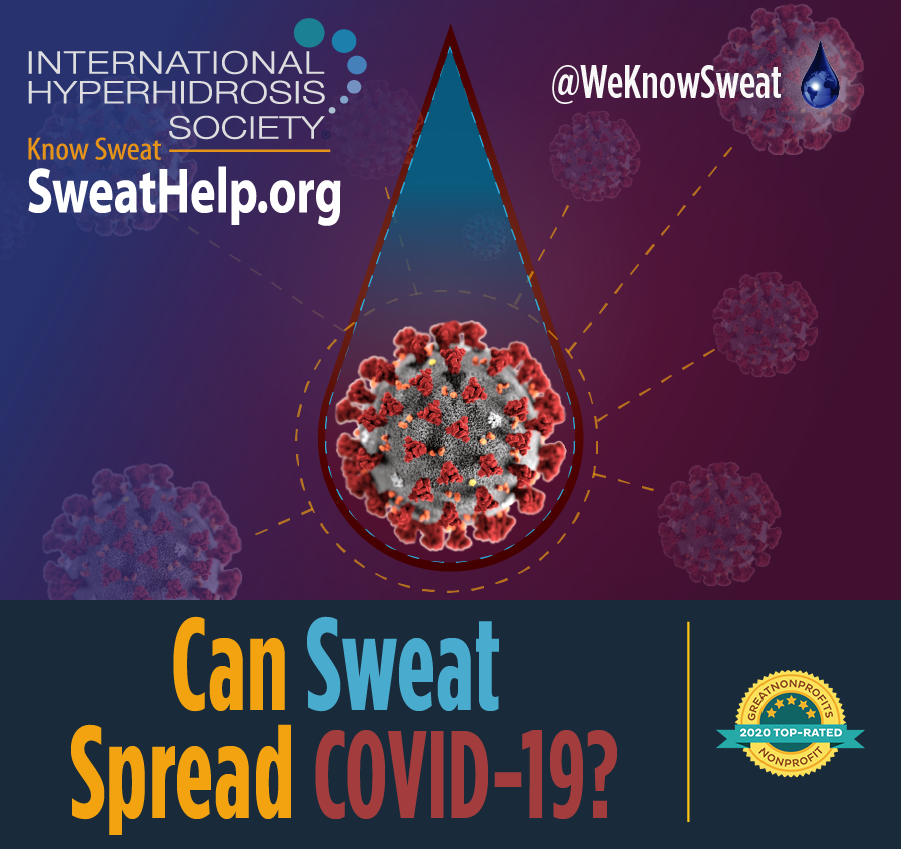


Here at the International Hyperhidrosis Society, we focus on a full range of sweat topics. From excessive sweating (hyperhidrosis) to the absence of sweating (anhidrosis), we strive to provide trustworthy, expert-derived information to keep you up-to-date and prepared. In that vein, we're bringing you important information from thought leaders about sweat and COVID-19...
Scientists say there's no evidence that sweat, by itself, can transmit COVID-19.
Rather, experts say, perspiration would need to become contaminated with virus-laden respiratory droplets, phlegm or mucus from an infected person and then come into direct contact with another person's mouth, nose, or eye mucous membranes in order for a sweat-borne infection to occur.
And, believe it or not, sweat could actually perhaps help prevent the transmission of COVID-19 (among other things) says Dr. Adam Friedman*, Professor and Interim Chair, Department of Dermatology at the George Washington University. "Sweat," he says, "has some inherent antimicrobial activity. The sweat nitrate becomes acidified when it hits the skin, generating nitric oxide, which is one of the most potent broad spectrum antimicrobial agents. In fact, gaseous nitric oxide is being currently studied as a potential treatment for some of the severe complications related to COVID-19."
Of course we must also remember regarding any sweat concerns, that in potentially hot, indoor places (like the gym or subway) physical distancing can be difficult. Also, that respiratory droplets from an infected person could land on surfaces others touch and where viruses might live for a few hours or sometimes days (depending on surface, temperature and other factors in the environment.) For instance, a report in the New England Journal of Medicine (NEJM) says a small amount of the new coronavirus can still be detected on plastic surfaces for up to three days, on stainless steel for up to two days, and up to one day on cardboard. But even with that, risks of infection through touch are likely small, says a professor of cell biology with The Johns Hopkins University, as the amount of virus lingering on surfaces for long periods is less than 0.1% of the starting virus material.
For anyone worried about catching or spreading COVID-19 via sweat right now, it’s probably more productive to instead maintain vigilance regarding the key tenets we’ve been hearing for weeks:
A silver-lining for hyperhidrosis sufferers: Physical distancing, working from home when possible, avoiding touch (especially handshakes and hugs), and fastidious cleaning, as well as frequent handwashing, showering and clothing changes are habits that already come naturally to many of us!
To learn more about COVID-19, how to better protect yourself, your family and your community, common symptoms, and what to do if you are sick or think you’ve been exposed, please visit the U.S. Centers for Disease Control and Prevention (CDC) or World Health Organization (WHO). If you're looking for Hh-friendly cloth masks, check out the $10 options from our friends and supporters at Wicked Sheets made from asthma & allergy friendly® certified fabric. #COVIDKindness
Thanks for being part of our supportive and informed hyperhidrosis community!
Wouldn't it be great to receive this sort of information right in your inbox? Subscribe today so you don't miss a thing. Our informational services are always free and we love being in touch with you.
*By the way, Dr. Friedman, quoted above, was co-chair, host and faculty member at the International Hyperhidrosis Society's 2019 Hyperhidrosis (Hh) Master Class in Patient Care and Practice Efficiency. His roles at George Washington School of Medicine and Health Sciences are extensive and includes what's already been mentioned as well as Residency Program Director, Director of Translational Research, Director of Supportive Oncodermatology GW's Department of Dermatology.
Latest Blogs